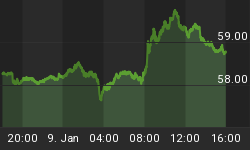They say you'll know the precious metals market's reached its peak when old ladies are melting down their fine silver, men are hocking their gold jewelry, and everywhere you look there's a seminar on how to make a fortune in metals.
It just happened recently in real estate. Remember one day people were refinancing there homes to take advantage of low interest rates, and then suddenly the next everyone wants to be a realtor and there's several shows on TV about "flipping" houses.
And, of course, right after that... the market tanks. That's how tops typically work. A market must have winners and losers, two sides to every trade. The success of a few early participants attracts more and more new players until the market can no longer sustain the pace and collapses under its own weight. It's the euphoria - like, say, predicting Dow 14,000 just as the market screams up to 13,000 - that usually signals the switch in advance to savvy traders. Now, calling tops with quirky indicators is practically a cottage industry. One more that could be added to the list is the silverscreen.
The chart below shows the release of two big Hollywood motion pictures about traders and stock market culture. Of course, big budget Hollywood producers and A-list celebrities don't like to take big hedge-fund-style risks. When they invest years of work or $100 million in a project, they're usually pretty sure there's going to be an audience or they'd never get on board.

In 1987, the high times surrounding a booming economy, in contrast to the high inflation and interest rates of the 70's, had producers convinced they could make a splash with a movie about stock brokers and corporate raiders. Of course, Wall Street was a blockbuster hit and Michael Douglas won a Best Actor Oscar for his portrayal of Gordon Gecko. But, to traders 1987 stands out more for the stock market collapse that October. Black Monday. A real market top.
After the huge tech-driven bubble at the end of the 90's, Hollywood again found an opportunity in putting traders on the screen. Boiler Room was released in 2000, a year infamous to traders as the "dot com collapse." The chart below shows the devastating selloff after the last market top, particularly for stocks related to the "tech bubble."

Of course since then, the markets have left behind those troubling times and staged huge recoveries. The Dow has reached new all-time highs and the S&P 500 is only about 50 points below its 2000 peak. Record-breaking private equity buyouts have been almost a weekly occurrence, and massive hedge-funds continue to extend their highly-leveraged grasp into swollen derivatives markets.

And, amidst the furor of a market rally that refuses to quit, 20th Century Fox announced the production of a sequel to Wall Street, titled Money Never Sleeps. Only Douglas' Gordon Gecko character will be reprised in the new picture, but rather than the corporate that typified the 80s, Gecko will now be a hedge fund manager with global reach.
Which begs the question... is this a sign? You be the judge. But, if history is any indicator, these charts indicate the return of the Gecko could be a real monster for Wall Street.
This article will also appear in SFO Straight Talk.
Dominick Mazza is a technical analyst and founder of Tradingthecharts.com, which specializes in using Elliott Wave, Fibonacci, and proprietary indicators. www.tradingthecharts.com.















